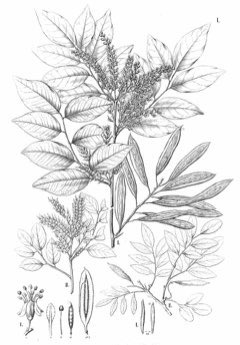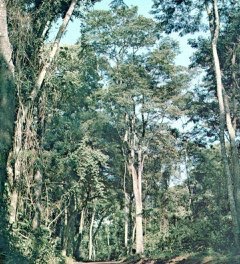 |
|
http://www.edibleplants.org |
 |
| Jorge Vallmitjana |
Translate this page:
Summary
Myrocarpus frondosus is a deciduous tree growing about 30 m in height, with an open and upright crown and bole that can be up to 90 cm in diameter. It is commonly found in South America particularly in Argentina, Paraguay, Brazil, and Bolivia where it is highly valued for its timber. It is also used medicinally to treat rheumatism, respiratory problems, cystitis, and urethritis. Essential oil from the resin is used in perfumery.
Physical Characteristics

 Myrocarpus frondosus is a deciduous Tree growing to 25 m (82ft) by 20 m (65ft) at a medium rate.
Myrocarpus frondosus is a deciduous Tree growing to 25 m (82ft) by 20 m (65ft) at a medium rate.
See above for USDA hardiness. It is hardy to UK zone 10. The flowers are pollinated by Bees, Insects.
It can fix Nitrogen.
Suitable for: light (sandy), medium (loamy) and heavy (clay) soils and prefers well-drained soil. Suitable pH: mildly acid, neutral and basic (mildly alkaline) soils. It cannot grow in the shade. It prefers moist soil.
UK Hardiness Map
US Hardiness Map
Synonyms
Leptolobium punctatum Benth. Myrocarpus paraguariensis Hallier f.
Plant Habitats
Edible Uses
References More on Edible Uses
Medicinal Uses
Plants For A Future can not take any responsibility for any adverse effects from the use of plants. Always seek advice from a professional before using a plant medicinally.
Antirheumatic Expectorant
The sap is expectorant[739 ]. The bark, the wood, and a resin obtained from them, are used in a tincture that is recommended for treating respiratory ailments, cystitis and urethritis[739 ]. The tincture is applied externally for healing injuries and treating rheumatism[528 , 739 ]. The seedpods are antidyspeptic and excitant[739 ]. An essential oil in the resin has nerolidol as its major constituent[739 ].
References More on Medicinal Uses
The Bookshop: Edible Plant Books
Our Latest books on Perennial Plants For Food Forests and Permaculture Gardens in paperback or digital formats.

Edible Tropical Plants
Food Forest Plants for Hotter Conditions: 250+ Plants For Tropical Food Forests & Permaculture Gardens.
More

Edible Temperate Plants
Plants for Your Food Forest: 500 Plants for Temperate Food Forests & Permaculture Gardens.
More

More Books
PFAF have eight books available in paperback and digital formats. Browse the shop for more information.
Shop Now
Other Uses
Cosmetic Essential Furniture Resin Wood
Other Uses An aromatic gum/resin is obtained from incisions in the trunk. It is widely used medicinally[419 ]. An essential oil obtained from the resin is used in perfumery[549 ]. The wood is fragrant and is sometimes burnt during ceremonies and as an insect repellent[402 ]. The heartwood is reddish-grey with yellowish spots; it is distinctly demarcated from the sapwood. The wood is very aromatic, medium-textured, irregular-grained, heavy, hard to cut and of great durability even when exposed to the elements. It polishes well to give a beautiful finish. A very useful timber, it is widely employed for a great many purposes including for outdoor purposes such as bridge beams, railway sleepers and posts; in construction for beams, rafters, laths, floor boards etc; for cabinet making, lathe work, cart bodies, panels, veneer etc[419 , 549 ].
Special Uses
Nitrogen Fixer
References More on Other Uses
Cultivation details
A plant of the subtropics to the tropics, being found in areas of seasonal rainfall and also all year rainfall, at elevations from near sea level to over 1,500 metres. Requires a sunny position[419 ]. Plants have a moderately fast rate of growth, able to reach a height of around 2.5 metres within 2 years from seed[419 ]. There are conflicting reports on whether or not this tree has a symbiotic relationship with certain soil bacteria, so it is unclear as to whether this tree fixes atmospheric nitrogen[755 ].
References Carbon Farming Information and Carbon Sequestration Information
Temperature Converter
Type a value in the Celsius field to convert the value to Fahrenheit:
Fahrenheit:
The PFAF Bookshop
Plants For A Future have a number of books available in paperback and digital form. Book titles include Edible Plants, Edible Perennials, Edible Trees,Edible Shrubs, Woodland Gardening, and Temperate Food Forest Plants. Our new book is Food Forest Plants For Hotter Conditions (Tropical and Sub-Tropical).
Shop Now
Plant Propagation
Seed - best sown as soon as it is ripe in a partially shaded position in a nursery seedbed or in individual containers. A germination rate in excess of 75% can be expected, with the seed sprouting within 10 - 15 days[419 ]. The seed has a short viability of less than 3 months in storage[419 ].
Other Names
If available other names are mentioned here
óleo-pardo - Portuguese, bálsamo - Portuguese, cabriúva-parda - Portuguese, incienso - Spanish. cabreuva, incienso, incienso amarillo, incienso blanco, incienso negro.
Native Range
SOUTHERN AMERICA: Brazil (Bahia (s.?), Espírito Santo, Minas Gerais, Paraná, Rio de Janeiro, Rio Grande do Sul, Santa Catarina, São Paulo), Argentina (Corrientes (northeast), Misiones), Paraguay
Weed Potential
Right plant wrong place. We are currently updating this section.
Please note that a plant may be invasive in one area but may not in your area so it's worth checking.
Conservation Status
IUCN Red List of Threatened Plants Status : Status: Data Deficient

Growth: S = slow M = medium F = fast. Soil: L = light (sandy) M = medium H = heavy (clay). pH: A = acid N = neutral B = basic (alkaline). Shade: F = full shade S = semi-shade N = no shade. Moisture: D = dry M = Moist We = wet Wa = water.
Now available:
Food Forest Plants for Mediterranean Conditions
350+ Perennial Plants For Mediterranean and Drier Food Forests and Permaculture Gardens.
[Paperback and eBook]
This is the third in Plants For A Future's series of plant guides for food forests tailored to
specific climate zones. Following volumes on temperate and tropical ecosystems, this book focuses
on species suited to Mediterranean conditions—regions with hot, dry summers and cool, wet winters,
often facing the added challenge of climate change.
Read More
Expert comment
Author
Allemão
Botanical References
Links / References
For a list of references used on this page please go here
A special thanks to Ken Fern for some of the information used on this page.
Readers comment
| Add a comment |
|
If you have important information about this plant that may help other users please add a comment or link below. Only comments or links that are felt to be directly relevant to a plant will be included. If you think a comment/link or information contained on this page is inaccurate or misleading we would welcome your feedback at [email protected]. If you have questions about a plant please use the Forum on this website as we do not have the resources to answer questions ourselves.
* Please note: the comments by website users are not necessarily those held by PFAF and may give misleading or inaccurate information.
To leave a comment please Register or login here All comments need to be approved so will not appear immediately.
|
Subject : Myrocarpus frondosus
|
|
|
|